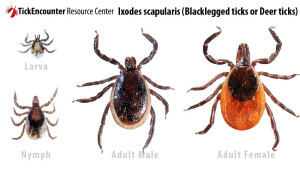This past Saturday, March 15, 2014 Amesbury Animal Hospital hosted a Equine Event on two topics, “Nutrition for the Aging Horse” and Dr Kirk Smith gave a lecture on “Lyme Disease”.
In this article I want to share what my take is on the discussion of Lyme disease. In one word “Prevention”. Lyme disease in horses is difficult to diagnose and can be easily misdiagnosed. Perhaps your horse is stiff or slightly off, has low energy levels and a cranky attitude. Yes, this could be many things and one of them is lyme disease.
One of the most useful tips I learned is using fly spray – BEFORE FLY SEASON. Dr. Smith mentioned that tick season starts in April and although I start treating my dog with Frontline in March (some dog owners treat year round) I don’t usually use fly spray on my horses until…well…fly season.
Dr Smith mentioned that treatment during non-fly season is probably only needed on the bottom half of your horse, legs, belly, etc. Because I have a small property my horses are not put out to graze so I will most likely only use spray when I’m out riding. My farm is located on the marshlands so we use perimeter sprays to help with ticks and mosquitoes (I wont even talk about greenheads…ouch).
Someone at the event inquired about what spray to use and if it was possible to just utilize a product normally used on people. What I got out of it… No, not a great idea. As a long time horse person I know most of us have our favorite sprays and they are all expensive (Pyranha, Ultra Shield, Repel-X, Equi-spot).
What we use at my farm…Because we treat our property with a fogging machine we buy a one gallon bottle of a concentrated permethrin (36.8% permethrin) which can be purchased at Dodges Agway in NH. It’s expensive at anywhere from $90.00 to $140.00. We found it online for $90.00. We use this for both perimeter spray and a horse spray. (We have a Skin So Soft solution for greenhead season). There are specific instructions on the container for correct measurements to mix for spraying on animals. (one gallon lasts us at least a year)
For all of you that prefer the natural way. We tried that first but the bug population here is just so high. The property is kept as clean and dry as possible (stone dust turnouts, no standing water, etc). We have bat houses and tried Guinea Hens (bats eat mosquito’s and guinea hens eat ticks and bugs off the ground). I’ve tried the foulest smelling “natural” fly sprays to no avail and I’ve heard quite a few horror stories about horses having reactions to untested natural products. (I’m still open to any suggestions)
Another major preventative measure is to simply check for ticks after a ride . Luckily for me they are easy to spot on my Palomino and even with fly spray on I’ve plucked a few off. A tick needs to be attached (engorged) for a 24 hour period to transfer the bacterium that causes the disease. So doing a quick check could save you and your horse from lyme disease.
Please note that I do not claim to be an expert on this. I am simply sharing what I’ve learned over the years and at the Equine Event compliments of Dr Smith of Amesbury Animal Hospital. The pest control measures I take are what works for me on my farm in Newbury, MA and I’m sure different areas have varied needs. Please feel free to share your thoughts on prevention and/or pest control.

